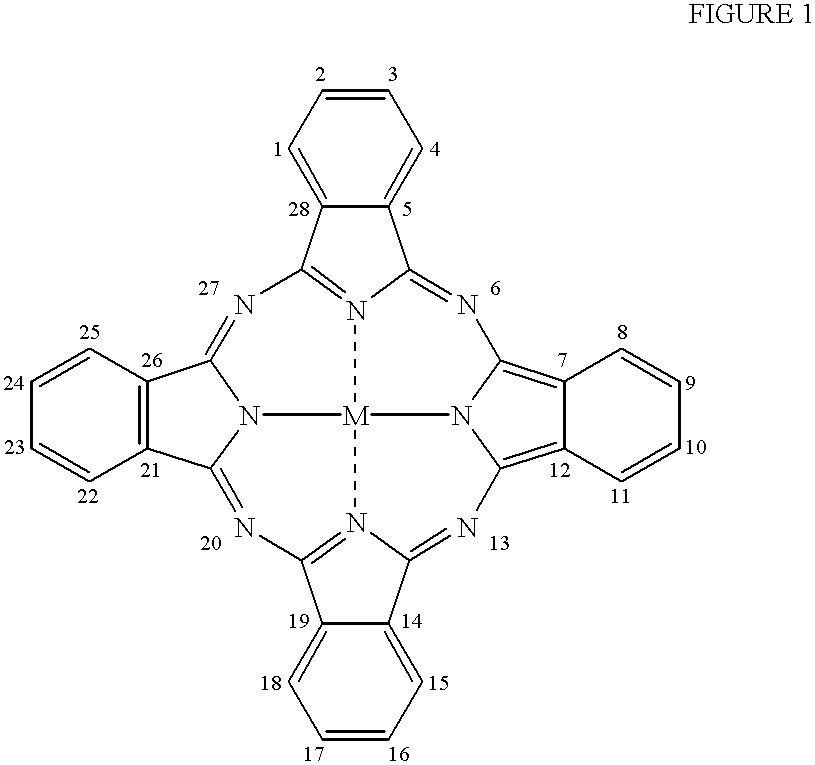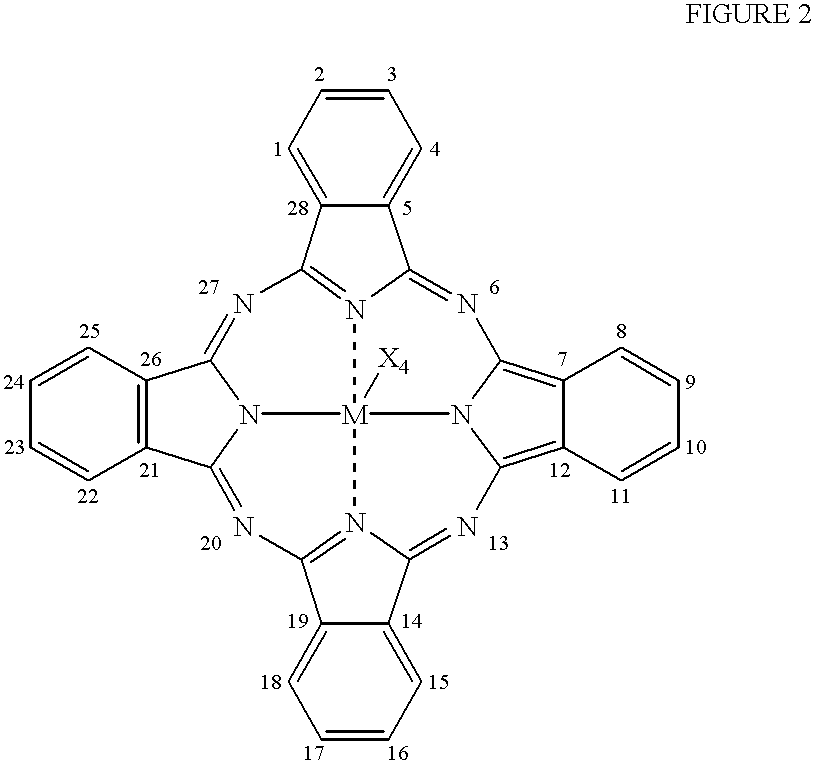Cleaning compositions
Inactive Publication Date: 2002-01-15
THE PROCTER & GAMBLE COMPANY
View PDF6 Cites 32 Cited by
- Summary
- Abstract
- Description
- Claims
- Application Information
AI Technical Summary
Problems solved by technology
A limitation to the use of some of these more water-soluble photo-bleaches can be their poor surface-activity.
One problem associated with the use of phthalocyanine, naphthalocyanines, and porphyrin photo-bleaching compounds arises from the fact that these are not water soluble, in particular when the parent rings are substituted solely with hydrogen.
However, a problem relating to the introduction of (high numbers of) substituent groups to the photo-bleaching compound (to ensure a certain level of water solubility) is that the photo-bleaching properties of the ring system are often affected.
For example, a change which increases solubility may reduce the quantum efficiency of the molecule.
This can render the derivative compound without sufficient photo-bleaching properties.
Secondly, the absorption spectrum may change, leading to an undesirable colouring of the photo-bleaching compounds in use, which is in particular a problem when used for photo-bleaching of fabrics.
However, the preparation of these derivative photo-bleaching agents can proceed in low yield which introduces impurities and increases cost.
These impurities may also introduce undesirable colouring which produces staining, in particular when used on fabric.
Another major limitation to the use of most photo-bleaching compounds known in the art is that they are highly coloured materials (having an absorption in the range of 600-800 nanometres).
For example, high concentrations of these compounds on the fabric will thus lead to staining of the fabric.
Yet another limitation of most photo-bleaching compounds known in the art is that introduction of solubilising groups tends to destabilise the compounds so that they tend to decompose once exposed to light, in particular sunlight, which deactivates them as photo-bleaching compound, thus leading to a lesser bleaching performance.
Furthermore, in cleaning compositions containing the photo-bleaching compounds it is often required that additional bleaching agents are present.
However, these bleaching agents can also cause decomposition and inactivation of the photo-bleaching agents.
However, if L is too reactive, this activator will be difficult to stabilize for use in a bleaching composition.
Method used
the structure of the environmentally friendly knitted fabric provided by the present invention; figure 2 Flow chart of the yarn wrapping machine for environmentally friendly knitted fabrics and storage devices; image 3 Is the parameter map of the yarn covering machine
View moreImage
Smart Image Click on the blue labels to locate them in the text.
Smart ImageViewing Examples
Examples
Experimental program
Comparison scheme
Effect test
example 2
EXAMPLE 3
The following liquid detergent is in accord with the invention
example 4
EXAMPLE 5
The following detergent formulations, according, to the present invention were prepared:
example 6
The following liquid detergent formulations are in accord with the invention (levels are given in parts per weight):
the structure of the environmentally friendly knitted fabric provided by the present invention; figure 2 Flow chart of the yarn wrapping machine for environmentally friendly knitted fabrics and storage devices; image 3 Is the parameter map of the yarn covering machine
Login to View More PUM
 Login to View More
Login to View More Abstract
The present invention relates to a photo bleaching compositions comprising:A) from 0.5 ppm by weight, of a photo bleaching agent, said agent comprising:a) a polymeric component, said polymeric component comprising one or more polymeric compounds having an average molecular weight of from 500 to 1,000,000 wherein at least 50% of the monomers which comprise said polymeric compounds comprise one or more di-polar, aprotic groups and have a polymerizable vinyl moiety, the balance comprising monomers selected from the group consisting of acrylic acid, acrylic acid esters, acrylic acid amides, methacrylic acid, methacrylic acid esters, methacrylic acid amides, and mixtures thereof; andb) a photo bleaching component, said photobleaching component comprising a porphyrin or a phthalocyanine ring wherein said phthalocyanine ring can optionally be substituted at one or more ring positions, and said ring comprising a transition metal or cation having an oxidation state of two or greater;wherein said photo bleaching component is integrated with said polymeric component to form said photo bleaching agent and the weight ratio of polymeric component (a) to photobleaching component (b) is from 1:1 to 1000:1;B) from 0.1% by weight, of a peroxy acid bleaching compound precursor; andC) the balance carriers and adjunct ingredients.
Description
The invention relates to bleaching compositions and cleaning compositions comprising the bleaching compositions, containing a specific photo-bleaching agent and a bleaching agent capable of providing a peroxyacid bleaching compound. The compositions are particularly useful in laundry and dish washing processes to provide enhanced photo-bleaching performance, fabric whiteness appearance and overall cleaning.Various compounds are known in the art which, upon exposure to light, can be photo-activated, to become an active species for chemical or further photo-chemical reactions.Two general examples thereof are porphyrin and phthalocyanine photo-bleaching compounds. These compounds, unmetallated and especially when combined with a suitable cation, can undergo a series of reactions, starting with a photochemical reaction step which transforms the compound into an excited state. The excited state of the molecule can react with stains to bleach them or alternatively after subsequent reactio...
Claims
the structure of the environmentally friendly knitted fabric provided by the present invention; figure 2 Flow chart of the yarn wrapping machine for environmentally friendly knitted fabrics and storage devices; image 3 Is the parameter map of the yarn covering machine
Login to View More Application Information
Patent Timeline
 Login to View More
Login to View More IPC IPC(8): C11D3/00C11D3/16C11D3/37C11D3/28C11D3/26D06L3/12C11D1/02C11D3/395C11D11/00
CPCC11D3/0063C11D3/168C11D3/3792C11D3/37C11D3/3776C11D3/28
Inventor BROOKER, ALAN THOMASHEINZMAN, STEPHEN WAYNEFIGUEROA, FRANCISCO RAMON
Owner THE PROCTER & GAMBLE COMPANY
Features
- R&D
- Intellectual Property
- Life Sciences
- Materials
- Tech Scout
Why Patsnap Eureka
- Unparalleled Data Quality
- Higher Quality Content
- 60% Fewer Hallucinations
Social media
Patsnap Eureka Blog
Learn More Browse by: Latest US Patents, China's latest patents, Technical Efficacy Thesaurus, Application Domain, Technology Topic, Popular Technical Reports.
© 2025 PatSnap. All rights reserved.Legal|Privacy policy|Modern Slavery Act Transparency Statement|Sitemap|About US| Contact US: help@patsnap.com



